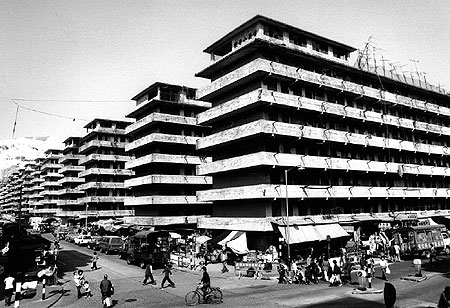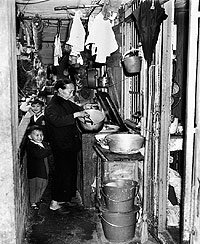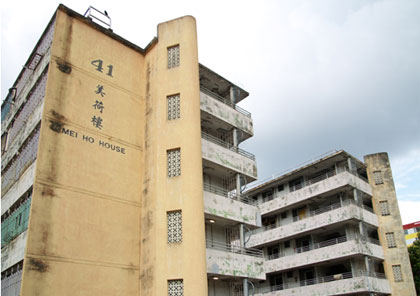History
1. The Shek Kip Mei Estate
2. Situation in late1940s
3. Shek Kip Mei Fire
Shek Kip Mei Estate
The massive fire gave birth formally to the public housing policy of the Government.
Shek Kip Mei Estate was the first public housing estate in Hong Kong.
It is located in Sham Shui Po and is under the management of the Hong Kong Housing Authority.
Consequently, the Colonial Government built a 29-block resettlement estate on the site of the burnt-down shanties to house the homeless victims.
Eight blocks (Blocks A to H), now renumbered as Blocks 10 through 13 and 35 through to 41, were constructed with the financial aid of the United Nations.
These 7 storey blocks were constructed in an 'H' configuration consisting of 2 residential wings,
with communal sanitary facilities linking them. Later towers were constructed with the single block configuration.
The Shek Kip Mei Estate was subdivided into "Upper" and "Lower" estates,
with the Upper estate being designated a "low-rent estate", and the Lower estate was designated a "Resettlement estate".
Housing units were little more than small cubicles, only about 300 square feet (24 to 28 square metres).
Each unit housed 5 people, and each building had a capacity of 2,500 people.
The rent was HK$ 14 a month.
In contrast, the rent for a commercial store downstairs was HK$100 per month.
Foreign tourists visiting the apartment complexes referred to them as "prisons".
They were in reality often occupied by more than one family due to the extreme shortage of available housing. Facilities and sanitation were primitive, and communal.
Until the establishment of the Housing Authority in 1973, Hong Kong's public housing was administered by the Resettlement Department.
By that time, eleven old blocks of the estate had been pulled down,
and modernisation of 18 blocks of the resettlement estate had commenced.
Phased re-occupation of the re-numbered estate took place between 1978 and 1984.
The distinction between "Upper" and "Lower" estates ceased to exist henceforth.
Mei Ho house have come the only housing building in Shek Kip Mei left until now from 1950s.
It also the last remaining example of the "Mark II" building in a single-block configuration, is graded as "GradeI Historic building", and will be preserved tentatively as a record of Hong Kong's public housing development.



↑The 29-block resettlement estates.

↑A resettlement block resident cooking in the public corridor.

↑Mei Ho House is the only one left until now from 1950s